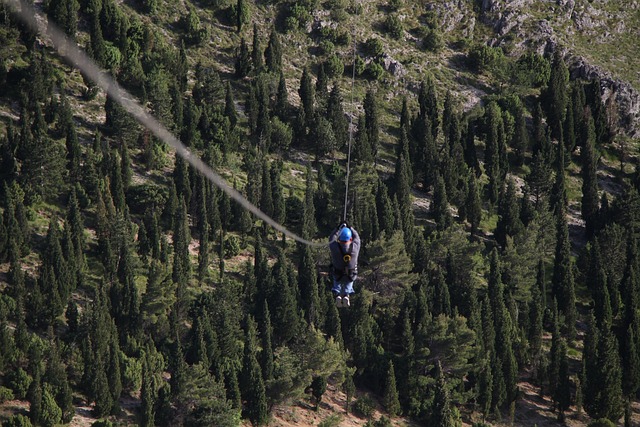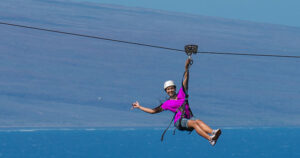Ziplining can potentially cause motion sickness due to the swaying and rocking of the harness and cable. However, the likelihood of experiencing motion sickness varies from person to person.
Ziplining has become a popular adventure activity for thrill-seekers. Flying through the air, suspended by a harness attached to a cable, is undoubtedly an adrenaline-pumping experience. While many people enjoy this adventure, others may be hesitant due to the possibility of experiencing motion sickness.
Motion sickness can occur when the brain receives conflicting signals from the eyes, ears, and joints. As ziplining involves swaying, spinning, and rocking movements, some people may experience motion sickness. However, the likelihood of this occurring can vary from person to person, depending on factors such as age, health, and susceptibility to motion sickness. In this article, we will explore the causes of motion sickness and the ways to prevent or minimize its effects while ziplining.

Credit: outdoordoer.com
Understanding Motion Sickness And Its Causes
Motion sickness can make you feel miserable and ruin your entire day. People who experience motion sickness are not always aware of what is happening to them and why they feel the way they do. Whether you are on a boat, in a car, or ziplining, motion sickness can strike anytime, anywhere, regardless of your age or physical conditioning.
In this section, we will explore what motion sickness is, the common symptoms of motion sickness, and the factors that contribute to motion sickness.
What Is Motion Sickness?
Motion sickness is the unpleasant feeling of nausea and dizziness that some people experience when they are in motion. Motion sickness is caused by the brain receiving conflicting signals from various parts of the body, such as the eyes and the ears.
It occurs when there is a mismatch between the sensory input that the brain receives from the eyes, inner ear, and muscles. Motion sickness can affect anyone, regardless of age or physical fitness.
What Are The Common Symptoms Of Motion Sickness?
Motion sickness symptoms can vary from person to person but typically include nausea, vomiting, dizziness, sweating, headache, and fatigue. Some people may only experience mild symptoms, while others may experience severe symptoms. Symptoms may also vary depending on the mode of transportation or the activity triggering the motion sickness.
Factors That Contribute To Motion Sickness
There are various factors that contribute to motion sickness. Some of the common contributors include:
Inner ear issues:
The inner ear is responsible for maintaining balance and spatial orientation. If there is a problem with the inner ear, it can cause motion sickness.
Vision problems:
Motion sickness can occur when the eyes and the ears send different signals to the brain about the body’s movement. For example, if you read while in a car, your eyes may signal that you are stationary while your body signals that you are moving, leading to a sensory conflict.
Motion confusion:
Motion confusion happens when the body senses movement that isn’t seen or vice versa. This can happen when the vehicle moves smoothly, and there is no visual cue to match the motion.
Sensory conflict:
Sensory conflict happens when the eyes and the ears send conflicting signals to the brain about the body’s movement. For example, when flying in an airplane, your ears may sense that you are moving, but your eyes see that you are still, leading to sensory conflict.
Motion sickness can occur anytime, anywhere and can happen to anyone. Understanding motion sickness and its causes can help minimize its symptoms when traveling or engaging in activities such as ziplining. It’s crucial to pay attention to your body’s signals and take necessary measures to prevent motion sickness and enjoy your adventures.
Can Ziplining Cause Motion Sickness?
Exploring The Physics Of Ziplining And Its Effects On The Body
Ziplining is gaining popularity worldwide as an adventurous outdoor activity that satisfies thrill-seekers. Gravity pulls you down as you slide down the zip wire, but the zip line changes its angle of descent and might include twists and turns. The physics of ziplining can cause motion sickness since it changes the balance and equilibrium of the body.
The vestibular system in the inner ear helps maintain balance in the body. The movement in ziplining might cause the fluid in the ear to move, sending mixed signals to the brain. The brain might find it hard to process this information and cause symptoms of motion sickness.
Some people may experience nausea, dizziness, sweating, and vomiting.
Research Studies On Ziplining And Motion Sickness
This is a lack of scientific research on motion sickness caused by ziplining. Nonetheless, studies show that individuals who are prone to motion sickness may experience symptoms while ziplining. Factors like age, gender, and anxiety levels can affect how individuals react to ziplining.
Studies suggest that women are more prone to motion sickness than men.
Moreover, the speed and height of the zipline can affect motion sickness. According to a study published by the annals of otology, rhinology & laryngology journal, individuals riding faster ziplines experienced more motion sickness. However, there’s no concrete evidence to suggest the prevalence of motion sickness in ziplining, but anecdotal evidence suggests that it’s a common occurrence.
Understanding The Individual Susceptibility To Motion Sickness From Ziplining
Several factors can affect the individual susceptibility to motion sickness from ziplining. Factors like age, gender, and anxiety levels can affect how individuals react to ziplining. The vestibular system’s sensitivity and the visual stimulation can also affect motion sickness. Additionally, past experiences with motion sickness can make one more prone to motion sickness during ziplining.
It’s essential to prepare adequately for ziplining to minimize the impact of motion sickness. Incorporating techniques like deep breathing, focusing on a fixed point and pre-boarding hydration can reduce motion sickness symptoms. Moreover, choosing slower ziplines that have fewer twists and turns can also minimize motion sickness.
Ziplining can cause motion sickness when the vestibular system sends mixed signals to the brain. Research studies suggest that susceptible individuals experience motion sickness while ziplining, while anecdotal evidence confirms common occurrence. It’s essential to recognize the factors that affect the individual susceptibility to motion sickness in ziplining and implement techniques to reduce the effects.
Frequently Asked Questions For Does Ziplining Cause Motion Sickness?
Does Ziplining Make You Dizzy?
Yes, it’s common to experience dizziness due to the height and speed involved in ziplining.
Can Ziplining Cause Nausea?
Yes, motion sickness is a common side effect of ziplining and can cause nausea, dizziness, and vomiting.
How Do You Prevent Motion Sickness While Ziplining?
You can try looking at a fixed point in the distance, taking breaks, staying hydrated and eating a light meal before ziplining.
Conclusion
After exploring the different factors that lead to motion sickness while ziplining, it’s clear that the experience is unique to each individual. Despite the potential disorientation from the speed and height, many people enjoy ziplining without any negative effects. However, those who are prone to motion sickness should take the necessary precautions to minimize their symptoms, such as medication or selecting a slower and shorter zipline course.
It’s also important to note that ziplining companies should provide adequate safety measures and instructions to ensure a safe and enjoyable experience for all. Overall, while ziplining may cause motion sickness for some, it doesn’t detract from the exhilaration of flying through the air and experiencing the stunning panoramic views.
So, grab your harness, conquer your fears and enjoy the ride!




